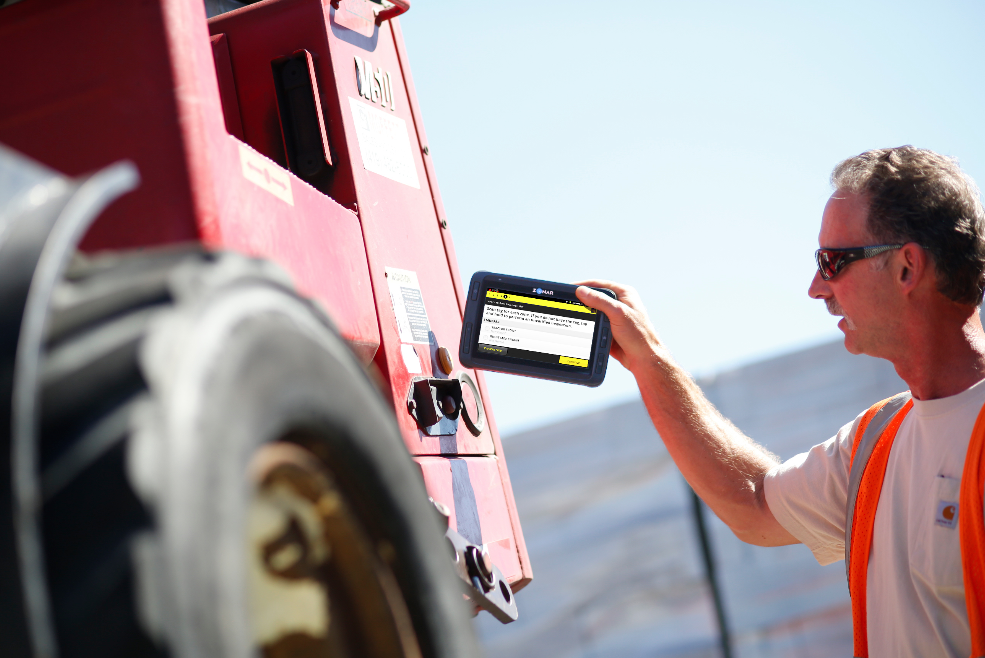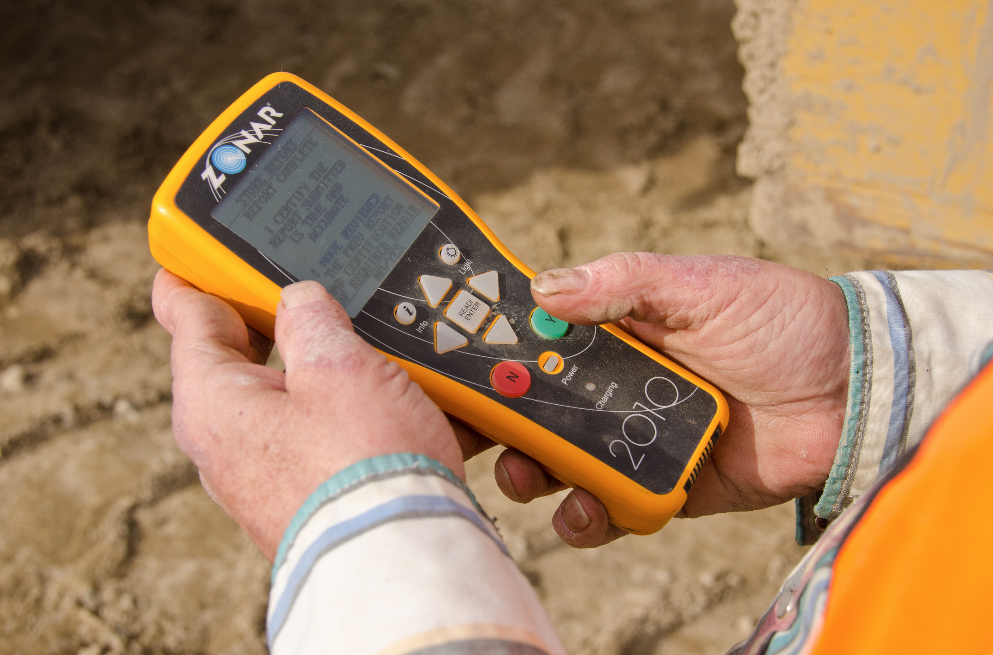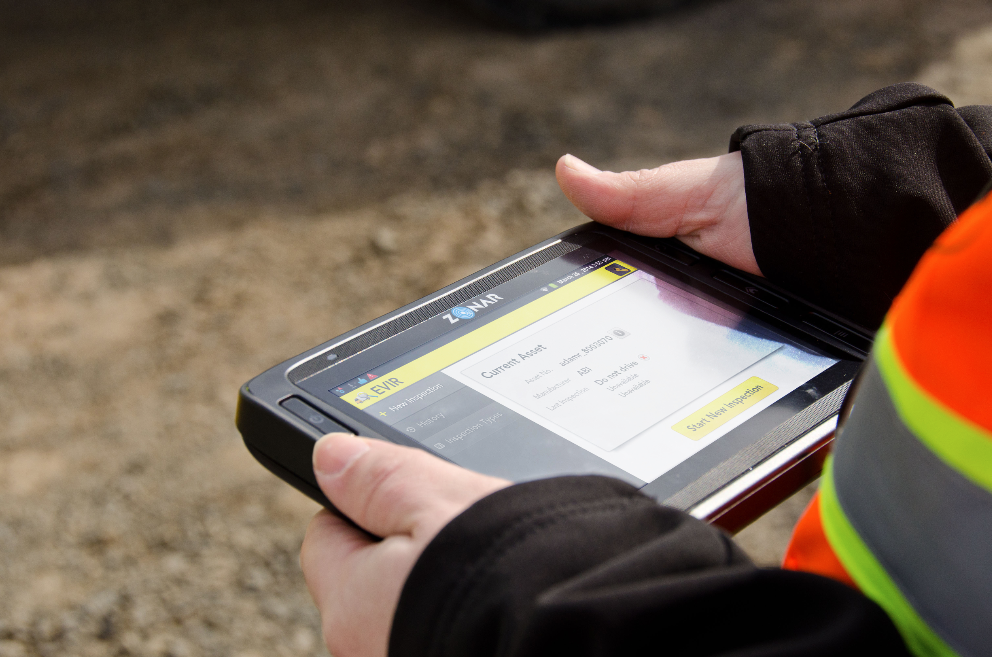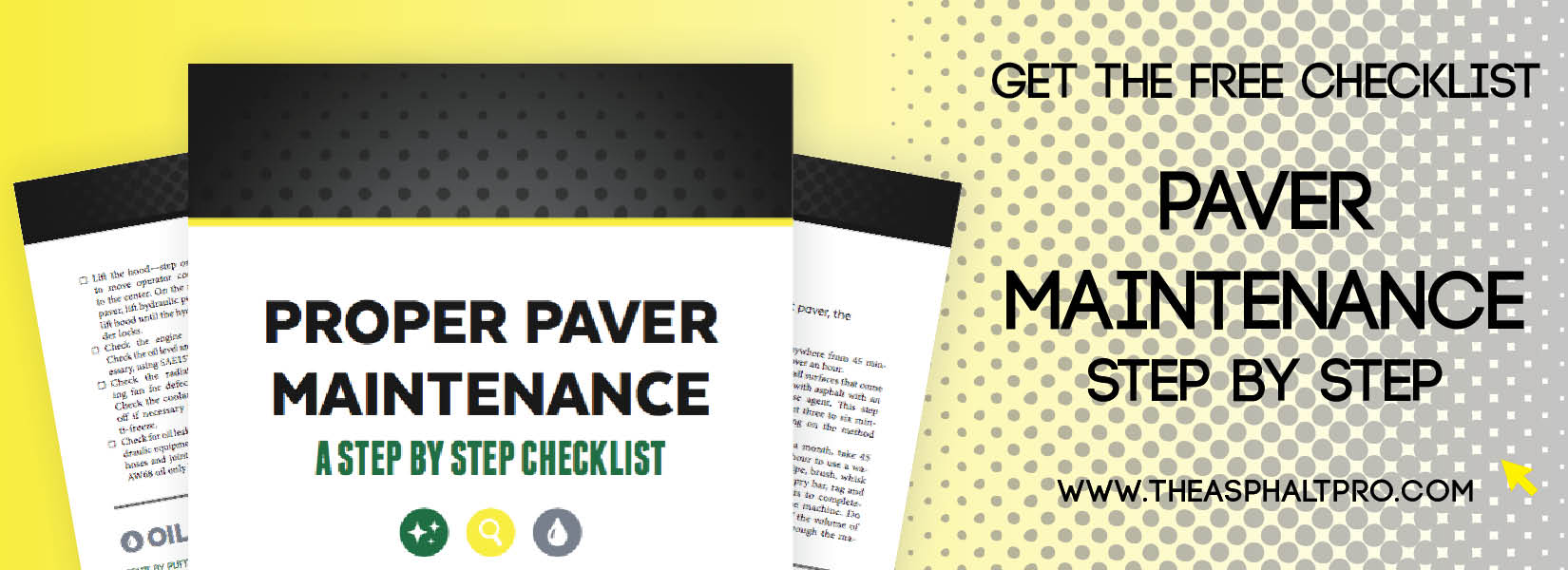Mobile Fleet Inspections Offer Efficiency
BY Sandy Lender

In the June 2013 edition of AsphaltPro, we shared the inner workings of the Guardian telematics from Roadtec, Chattanooga. Since then, we’ve shared updates to that system and innovations in other OEMs’ telematics. At the 2016 World of Asphalt trade show in Nashville, I visited with the team from Zonar Systems, Seattle, to discuss their 2010™ electronic verified inspection reporting, which you can read about below. These days, placing RFID tags on equipment does far more than track hours of service. The team from Caterpillar sat down to prepare a list of four specific ways mobile inspection apps help you keep equipment running at optimum levels. Consider these points:
- Mobile inspections gather information quickly and accurately—most support photographs to be sent along with descriptions. Paper inspection forms are often compiled over time and so become disjointed and without a logical sequence to how a walk-around inspection should progress.
- Mobile inspection forms are electronic and can be updated or added to quickly. If you need to conduct special inspections, or include inspection points for equipment recently added to the fleet, you can send updated forms right to their smart phone or tablet.
- Because mobile inspection forms are electronic, the information gathered can be transferred into other systems in service or the office. The more times you avoid manual data entry, the more accurately you maintain the equipment.
- Some mobile inspection apps can also escalate repair events, order parts or open work orders, so your downtime is kept to an absolute minimum.
Of course, the folks at Cat have an interest in sharing this information. Your Cat dealer can show you how Cat Inspect®, Caterpillar’s mobile inspection application, can turn your team into walk-around inspection experts. There’s no cost to download their mobile app. The app is available for Apple devices on iOS7 and newer, Android devices on Jelly Bean 4.1 and newer, and Windows 8.0 and newer tablets.

To use the system, RFID tags are placed on the piece of equipment at critical inspection points. These are called “zones.” When the equipment operator approaches the vehicle for the day’s shift, he turns on the handheld Zonar 2010™ EVIR reader, pictured here, which is also called the inspection tool. He holds the reader close to the RFID tag at each inspection zone.
Plenty of OEMs have gotten into the market of making inspections more efficient through mobile formats. The Zonar system mentioned above is one such system. In fact, The team at Superior Bowen Asphalt, Kansas City, Missouri, shared an overall maintenance strategy that contractors can learn from using technology from Zonar Systems.
The Superior Bowen team was able to integrate its existing Viewpoint system with the Zonar 2020® tablet, ZLogs® and ZTrak® asset tracker. All that Z-lingo means the company put a number of asset-tracking technologies together on the entire fleet—from milling machines to pick-up trucks to material transfer vehicles. Now personnel from mechanics to operators to bean counters in the home office can measure real-time telematics with any piece of equipment that’s equipped with the Electronic Vehicle Inspection Reports (EVIR®) and additional commercial navigation tools. President Trey Bowen said, “What gets measured, gets done is our motto. Zonar helps us to do this.”
Previously, Superior Bowen Asphalt didn’t have a company-wide technology-based tracking and reporting system to manage a proactive maintenance schedule for drivers and equipment operators. Managers admit to have an “on-the-fly” approach to these operations, which made it challenging for the appropriate personnel to monitor, track and maintain equipment.
To ensure the on-road and off-road machines’ safety issues were addressed quickly and efficiently, Superior Bowen developed a long-term business plan that identified goals of having a world-class response time for maintenance, and world-class maintenance levels. To meet the goals, the team needed a strong yet flexible tracking and reporting infrastructure that would integrate with its existing Viewpoint system.
In 2012, Superior Bowen set up a pilot program with Zonar, beginning with the deployment of Zonar telematics on the company’s on-road vehicles. By fall 2014, the company expanded the program, deploying the Zonar 2020 tablet in all the assets across the fleet. As part of the implementation, Superior Bowen integrated Zonar into its Viewpoint system while maintaining the configurations of their operator care standards. The new solution provided real-time updates for the planner and team, which allowed them to make sure the notifications and paperwork reached the right people and was completed in a timely fashion. The ability to report directly from their own devices by working with the Zonar 2020 tablet enabled Superior Bowen employees to better manage their equipment care and service while maintaining the supervision and tracking required for overall operational efficiency.
The result was a reduction in the number of emergency breakdowns from 30 percent to 10 percent in 2015—achieving a best-in-class percentage. The company is currently working toward world-class levels at 3 percent.

The EVIR allows time-stamped reporting and alerts to automate the service and repair scheduling for equipment.
To use the system, RFID tags are placed on the piece of equipment at critical inspection points. These are called “zones.” When the equipment operator approaches the vehicle for the day’s shift, he turns on the handheld Zonar 2010™ EVIR reader, which is also called the inspection tool. He holds the reader close to the RFID tag at each inspection zone. When the reader is within range of the tag, it displays a menu that the operator will interact with, responding to questions with push-button answers. After the operator has completed the inspection of the vehicle, he places the inspection tool into the vehicle mount in the cab. It then transmits information to Zonar’s Ground Traffic Control web application. If the operator has inadvertently skipped one of the inspection zones, the reader will alert him. The information going back to headquarters lets managers know that all is well with the machine; it has been greased, oiled, fueled, etc. Or managers can be notified if something on the machine needs to be addressed immediately or in the near future. The EVIR allows time-stamped reporting and alerts to automate the service and repair scheduling for equipment. According to the manufacturer, this system complies with DOT, OSHA and MSHA inspection regulations.
In 2015, Superior Bowen had 0 percent drivers out of service, and sustained their vehicle out-of-service rates at a low 12.5 percent. Using the Zonar tools, the newly hired Superior Bowen planner was able to maintain his load at above 90 percent. By deploying the Zonar 2020 across the fleet, Superior Bowen was able to improve report tracking responsiveness and accuracy. The team-deployed Zonar tracker technologies and RFID tags give operators better visibility into their self-contained crews to manage assets remotely. Managers perform monthly crew audits, which are key in meeting service level requirements. Since the Zonar solutions have been in place, more than 90 percent of vehicles have passed.
Check into this option for your fleet management and see where such efficiencies can improve your bottom line.

